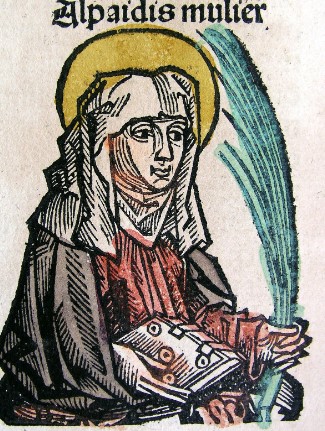
Date of Birth
circa 637
Place of Birth
Heristal, Liege, Belgium, Netherlands
Towns / Cities Moved Into
Heristal, Liege, Belgium, Netherlands |
Brabant, Antwerp, Belgium, Netherlands
Known Occupation
-
Religion
-
Death Information
Year of death
705
Place of death
Orp-Jauche, Arrondissement de Nivelles, Walloon Brabant, Belgium
Cause of death
-
Burial location
Orp-le-Grand Monastery (In ruins)
Orp-Jauche, Arrondissement de Nivelles, Walloon Brabant, Belgium
Obituary

Parents

Childebrand Debruyeres

Clotilde Alpais Dheristal
Marital Status


Married Pepin “The Younger” De Heristal
Children



Narrative / Story
In the verdant landscapes of Heristal, Liege, in what is now Belgium and the Netherlands, circa 637, Duchess Aupais Chalpaide Von Bavaria was born into a world on the cusp of monumental change. Her birthplace, nestled in the heart of the Merovingian dynasty’s influence, was more than a mere backdrop to her life; it was a crucible of political and cultural ferment.
Aupais’s life, as a scion of nobility, was intricately woven into the tapestry of court intrigues and the weighty responsibilities that her lineage bestowed upon her. Her marriage to Pepin “The Younger” De Heristal was not just a union of two hearts but a strategic alliance that melded power and tradition. This marriage bore fruit not only in their children, including the notable Charles Martel, but also in the consolidation of their familial influence across the Frankish Kingdom.
The era in which Aupais lived was marked by the expansion of Frisia Magna, a testament to the growing influence of the Frisian territory. This expansion, while a symbol of prosperity, was not without its tribulations. The Frisian-Frankish wars, a series of conflicts borne out of this territorial expansion, painted the backdrop of her life with strokes of strife and political upheaval.
Frisia, during Aupais’s time, was a vibrant mosaic of cultures, languages, and ethnicities. As a cross-border cultural region, it was a nexus of trade and cultural exchange. The Frisians, renowned for their maritime skills, were pivotal in the international luxury trade network. This era’s prosperity, however, was interspersed with periods of competition and conflict, reflecting the complex socio-economic landscape of the time.
In this milieu, Aupais’s role as a duchess was deeply intertwined with the socio-political fabric of her society. While her noble status shielded her from direct discrimination, she lived in an era characterized by rigid social hierarchies and occasional social unrest. The societal structure was stratified, with the remnants of slavery giving way to a system of serfdom and tenant farming.
The societal expectations for women, particularly in noble families like that of Aupais, were predominantly centered around domestic management and participation in social and religious events. However, women of Aupais’s stature often wielded significant influence behind the scenes, shaping diplomatic relations and overseeing vast estates.
Aupais’s life was a reflection of the era’s complexities and contradictions. Her existence was not merely confined to the domestic sphere; she was an active participant in the unfolding historical narrative. Her influence, though perhaps not always recorded in the annals of history, was nonetheless significant in the shaping of her family’s legacy.
The year 705 marked the end of an epoch with the passing of Aupais in Brabant, Antwerp. Her demise was not just the closing of a chapter in a noble family’s history but also a signifier of the shifting tides in European history. The period of her life witnessed the rise and gradual subjugation of the Frisian Kingdom by the expanding Frankish empire.
In retrospect, Duchess Aupais Chalpaide Von Bavaria’s life story is more than a mere chronicle of a noblewoman’s existence. It is a narrative steeped in the cultural exchanges, socio-economic shifts, and political transformations of early medieval Europe. Her legacy, perpetuated through her descendants, especially Charles Martel, is indelibly etched into the fabric of European history.
Thus, the tale of Aupais is not just a recounting of personal triumphs and tribulations; it is a mirror reflecting the broader historical landscape of her time. Her life, interlaced with the rich tapestry of Frisian society’s evolution, offers a unique lens through which we can view and understand the complexities of an era that laid the foundations for the Europe we know today.